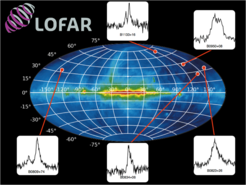Finger on the pulse of the pulsars
European LOFAR telescope provides the most sensitive observation to date at low frequency
An international team of astronomers including German scientists has succeeded in recording the most sensitive observations to date of pulsars at low frequency. The measurement was undertaken with the European LOFAR radio telescope network. Pulsars are fast-rotating neutron stars that are formed in the explosion of very massive stars (supernovae).

LOFAR, the European low frequency radio telescope, is the first of a whole series of new types of radio telescopes to investigate the universe at the lowest frequencies which are actually accessible from the ground. One of the key projects is to find and study new pulsars in this "radio window". The German GLOW (German Long Wavelength) consortium, whose membership includes the group of Michael Kramer, Director at the Max Planck Institute for Radio Astronomy in Bonn, is also involved.
“We are returning here to the radio frequencies where the pulsars were originally discovered in the 1960s,” says Ben Stappers from the University of Manchester, the lead author of the publication, which will be published soon in the scientific journal Astronomy & Astrophysics. “Except that with LOFAR we now have a telescope with abilities that we could not have dreamed of back then.”
The chance finding of the first pulsar in 1967 is one of the great discoveries of astronomy. The astronomers found the first pulsar signals with a radio telescope at the low frequency of 81 megahertz, quite close to the radio frequencies in the VHF range.
With LOFAR, the astronomers have now returned to the frequency range of the first pulsar measurements – but they are now using the latest computer technology and linking up the individual telescopes via high-speed fibre optic cables, which increase the power of the telescopes many times over. LOFAR will make it possible to investigate the radio pulses in detail and also to study effects of gravitational physics and properties of the interstellar medium in our Milky Way. “Even if these are only early test results, they nevertheless already demonstrate the spectacular possibilities offered by LOFAR,” says Stappers.
LOFAR operates with the aid of thousands of small antennas that are distributed across various European countries and networked via high-speed Internet connections. The evaluation is done using a powerful supercomputer near the central LOFAR station at ASTRON in the Netherlands.
The telescopes have no movable parts; instead, they are directed at the sky using digital time delay components. This provides much greater flexibility for the data analysis. Totally different directions in the sky can be covered simultaneously, for example, the only limiting factor being the computing capacity of the computer. This allows the sky to be surveyed much faster in the search for new pulsars.
